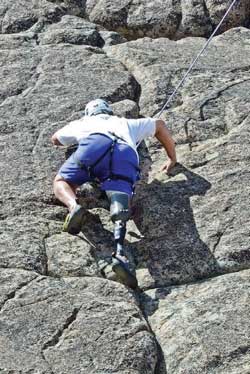Recreation Opportunity Spectrum and Recreation Site Scale
Recreation Opportunity Spectrum (ROS) classifications provide guidance on the:
-
Amount of development that is acceptable at any given site
-
Amount of deviation from the site's natural characteristics that is appropriate during development
-
Types of materials that are appropriate for the setting
-
Typical recreation activities in each setting classification (figure 23)

Figure 23—This free-style climber appears to enjoy the challenge, self-reliance, and independence characteristic of semi-primitive and primitive recreation opportunity spectrum settings. Photo credit: Disabled Sports USA, Rockville, MD
The spectrum assigns classifications of Urban, Rural, Roaded Natural, Semi-Primitive Motorized, Semi-Primitive Non-Motorized, and Primitive based on identified setting characteristics. Some units also include a Roaded Modified classification. Maps should be available at district or supervisor's offices showing ROS classification for the National Forest System lands administered by that unit. More information about ROS is available at http://www.fs.fed.us/cdt/carrying_capacity/rosfieldguide/ros_primer_and_field_guide.htm.
The amount of development at a site is described using a six-level recreation site planning development scale ranging from 0 (no site modification) to 5 (extensive site modification). Site modifications are provided for visitor convenience and comfort in recreation sites with characteristics meeting the criteria for scale level 3, 4, and 5. Rustic or rudimentary site modifications may be provided for resource protection at level 2 or less. Definitions of each level of the Forest Service's recreation site scale are included in the Forest Service Manual, Chapter 2330, exhibit 01.
Although neither ROS classifications nor the recreation site scale determine accessibility requirements, take both into account when designing site improvements. For instance, you may need improvements for resource protection in primitive and semi-primitive settings at recreation sites meeting the criteria for scale levels 1 or 2. In urban, rural, and roaded natural settings, you may want to provide improvements for visitor comfort and convenience at recreation sites meeting the criteria for scale levels 3, 4, or 5.

User Comments/Questions
Add Comment/Question